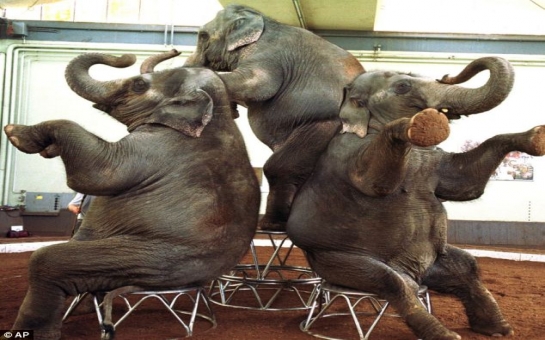They sat on their haunches, stood on their heads, and formed an elephantine train as they placed their forelegs on each other’s backs and trumpeted around the ring. In short, they performed every trick they had been tortured into learning, but they could not make up for the absence of the real star of the show, a five-ton Asian elephant named Mary. Mary’s talents included picking out 25 tunes on musical horns, which she tooted with her trunk. She was also the champion pitcher on the circus’s baseball team. But on that tragic day, she had been stripped of her red-and-gold saddle and head-dress of artificial blue feathers and stood tethered in disgrace outside the tent. Waiting there in the drizzling rain, it was said that she trembled fearfully, as if aware of the awful fate about to befall her. And well she might have done, for ‘Murderous Mary’, as she became known, had not only killed a man but had made the mistake of doing so near Erwin, Tennessee.This newly booming American railroad town had pretensions to civilisation, boasting its own post office, theatre and courthouse. It also had a jail, but the sheriff’s authority counted for little in a part of the world where mob rule still prevailed.Between 1882 and 1930, there were 214 victims of lynchings in Tennessee. Most were black men, summarily found guilty of such crimes as ‘fighting a white man’ and having ‘bad character’. But soon their tragic ranks would be joined by Mary, surely the only elephant in history ever to have been hanged.And it seems particularly pertinent to remember her in the week that Prince Charles hosted a much-heralded international conference to address the illegal trade in wildlife parts. Elephants were among the species highlighted as most at risk, but the supposedly enlightened Western world has not always been so concerned about the welfare of these majestic creatures, as we are reminded by the barbarity of Mary’s death.Her fate was sealed the day before the hanging, when Charlie Sparks’s circus train arrived in the small town of Kingsport, about 40 miles from Erwin. As always, it advertised its presence with a parade along the main street, during which Mary was ridden by 38-year-old Walter Eldridge, nicknamed Red because of his rusty-coloured hair.A drifter who had been with the circus only a day, he had no experience of handling elephants, but the only qualification required was the ability to wield an ‘elephant stick’ — a rod with a sharp spear at one end. A clue as to why this held such fear for the animals comes from an account of how a baby elephant named Mademoiselle Djek was tamed for a short stint on the London stage in 1829. While critics marvelled at her docility, Charles Reade, a novelist of the time, described how her keeper first gained mastery over her by stabbing her in the trunk with a pitchfork, at which she ‘wheeled round, ran her head into a corner, stuck out her great buttocks and trembled all over like a leaf’.He then jabbed her with all his force for half an hour until ‘the blood poured out of every square foot of her huge body’ and he had ‘filled her as full of holes as a cloved orange’.Similar techniques would have been used to break Mary. But although the elephant-stick usually kept her in line, she was suffering from a painfully abscessed tooth that day.When she stopped during the parade to nibble on a piece of discarded watermelon rind, Red Eldridge jabbed her to keep her moving and inadvertently hit the tender spot. Her reaction was swift and deadly. Reaching up with her trunk, she dashed him to the ground then stamped on his head. ‘Blood and brains and stuff just squirted all over the street,’ recalled one witness.As the terrified spectators screamed and fled, a local blacksmith shot Mary with a pistol, unloading five rounds of ammunition into her thick hide to little effect.She stood still, suddenly calm again and seemingly oblivious both to the bullets and the commotion as the townsfolk encircled her with chants of ‘Kill the elephant, kill the elephant.’Fearing that his dates in other towns would be cancelled if they heard that his circus was home to a homicidal pachyderm, Charlie Sparks had no choice but to give in to these demands for vengeance. The only question was how Mary should meet her end. Bullets had already proved ineffective and neither was poison likely to work, since elephants have some half a million sense receptors in their trunks and can easily detect noxious substances.Some people advocated crushing Mary slowly between two opposing railway engines. Others called for her head to be tied to one locomotive and her legs to another so that she would be dismembered alive as they set off in opposite directions.Another option was electrocution — there was a horrific precedent for this thanks to Thomas Edison, inventor of the first commercially viable electric light bulb. At a time when America was choosing which of the two main forms of electricity to adopt, direct current (DC) or alternating current (AC), he had patents for many devices using the former and stood to profit hugely if it was chosen over its rival.Claiming that DC was the safer of the two, he spread false stories about fatal accidents supposedly involving AC. He also staged various demonstrations in which animals were publicly electrocuted with AC, the most spectacular of which came about in 1903 when a new amusement park opened on New York’s Coney Island.One of the attractions was an elephant named Topsy, but it was claimed that she had become violent and uncooperative and the owners sought publicity for their new venture by executing her with Edison’s help.A huge crowd saw Topsy place her feet obediently into specially designed wooden sandals, lined with copper wiring and linked to an AC power supply. When the switch was thrown, smoke billowed up from her feet and within a minute or two it was all over. One newspaper reported the public’s morbid delight in watching her demise, even though it caused ‘an unpleasant smell to mingle with the scent of roasted peanuts, sold at two cents a bag’.Later it was said that Topsy’s ‘riding the lightning’ had briefly caused bulbs to dull all over the region, as if in commemoration of her, but her death proved in vain, because Edison’s plot failed and America eventually went with AC as its standard electricity current.This had reached rural Tennessee by 1916, but not with sufficient power to dispatch an elephant, so Charlie Sparks came up with the equally sensational idea of hanging Mary. The next day the circus visited Erwin, which had a 100-ton crane used to lift railway carriages on and off the tracks. This was strong enough to support an elephant, and the matinee-goers disappointed by not seeing Mary in the ring that afternoon were mollified by the news that they could see her being hanged shortly afterwards, at no additional charge.As she was led to the railway yard, Mary was followed by the circus’s other four elephants, each entwining their trunk in the tail of the animal in front just as they had done on countless parades.Charlie Sparks hoped that their presence would keep her compliant but, as a chain was placed around her neck at the ‘gallows’, they trumpeted mournfully to her and he feared that she might try to run away.To stop this happening, one of her legs was tethered to a rail. No one thought to release it as the crane whirred into action and, as she was hoisted into the air, there was an awful cracking noise, the sound of her bones and ligaments snapping under the strain.She had been raised no more than five feet when the chain around her neck broke, dropping her to the ground and breaking her hip. ‘It made a right smart little racket,’ recalled one of the crowd which was some 3,000-strong and included most of the town’s children.The onlookers panicked and ran for cover, but Mary simply sat there dazed and in terrible pain. Meanwhile, one of the circus hands ran up her back — as if climbing a small hill rather than a living creature — and attached a stronger chain.The winch was powered up again and this time Mary was raised high in the air, her thick legs thrashing and her agonised shrieks and grunts audible even over the laughter and cheers of those watching below. Finally she fell silent and hung there for half an hour before a local vet declared her dead.Her gruesome end is recorded in a photograph so horrifically surreal that some have suggested it must be a fake — but, all too sadly, its authenticity has been confirmed by other photographs taken at the time.That night the circus went ahead as usual, but after the show one of the remaining elephants broke away from the herd and began running towards the railway yard.Since wild elephants are thought to return to the bones of fallen family members for many years, he perhaps went in search of Mary. But he was quickly recaptured and returned to the life of captive misery from which he had escaped.Knowing that Mary no longer had to endure this cruel and unnatural existence is perhaps the only consolation to be drawn from this awful tale. Today she still lies interred in a huge grave which was dug for her using a steam shovel.Some said the hole was ‘as big as a barn’, but no one knows exactly where it is, or seems much inclined to find it. Tellingly, there remains no monument to her in Erwin, the town which hanged an elephant and apparently remains ashamed of having done so to this very day.(dailymail.co.uk)ANN.Az
Man's history of violence against animals is shameful - PHOTO
World
13:45 | 17.02.2014

Man's history of violence against animals is shameful - PHOTO
Trooping into the tatty Big Top to the accompaniment of a drunken four-piece band, the elephants in Charlie Sparks’s travelling circus did their best to entertain the audience on that cold afternoon in February 1916.
Follow us !










